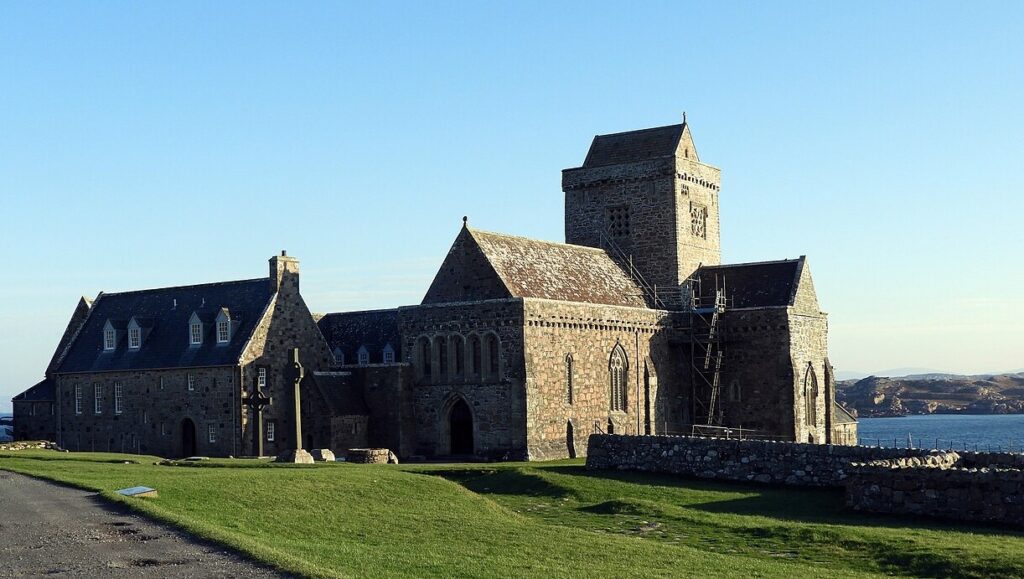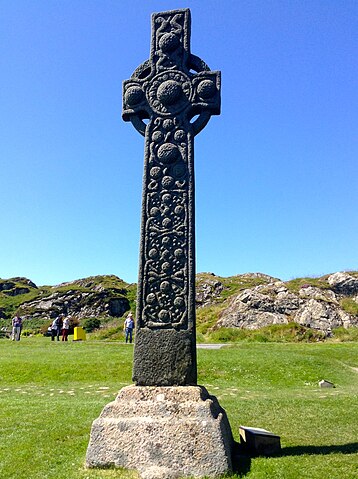by the Rev. Ernie Ashcroft
In July of next year, a group of folks from St John’s will travel to the Scottish Isle of Iona on a weeklong pilgrimage. Getting to the island is somewhat challenging! From Minnesota, we’ll:
- Take a plane into Glasgow;
- Then take a 3-hour train ride to Oban;
- Then take an hour-long ferry journey across the Firth of Lorn to the Isle of Mull;
- Then an hour-long bus trip (on a single-track road) brings you to Fionnphort;
- And from there, a short ferry ride to Iona;
- Finally, since no vehicles are permitted on Iona, folks will walk about a third of a mile to our accommodation at the Bishop’s House.
At this point you might be asking yourself, “Why put up with all that? Why are you all going to Iona?”
The answer is: sites (and sights) like this!

The scenery on the island is both rugged and spectacular. The island is so small it can easily be walked on foot in a few hours. Staying at the Bishop’s House requires that all guests to be committed to the daily worship and prayer services held in the chapel. All of this will give our pilgrims opportunities to reflect on the events and history of Christian communities on Iona, as well as to reflect and discern their next steps on their journey with God.

Iona Abbey is one of the oldest Christian religious centers in Western Europe. It was the focal point for the spread of Christianity throughout Scotland and was the location of a distinctively Celtic monastic community, founded by St Columba in 563 CE.
Under Columba, the Abbey became an important center for the production and safekeeping of Christian literature as well as philosophical and other important texts from antiquity.
The Book of Kells, one of the most important illuminated manuscripts and Celtic Gospel books, was composed on Iona in the 9th Century. It is a masterwork of Western Calligraphy and widely regarded as the pinnacle of Celtic illumination. It consists of the four Gospels, together with other texts and tables. It was taken to the Abbey of Kells in Ireland for safe keeping from Viking attacks.
In addition, the monks evangelized the Pict and Scots tribes of Scotland. The Abbey and its community exercised tremendous influence in the religious and civic life of Scotland for many centuries. This all finally came to an end in the 16th Century with the Scottish Protestant Reformation, when the Abbey was destroyed and the monks scattered.
The buildings remained in ruins until 1938, when a group led by George MacLeod began to rebuild the Abbey and established an ecumenical community on the island. This has now become a center for Christian pilgrimage, in part this because of the emphases of the community:
- a focus upon peace and justice issues
- a deep and practical concern for the environment
- a rigorous commitment to daily worship and prayer
- an openness to welcome all people

There is a Celtic saying that Heaven and earth are only three feet apart, but in “thin places” it is even smaller. The Celtic Christians identified Iona as one of these thin places, where the veil between this world and Heaven was almost nonexistent, making it a holy space where we can more easily encounter God.
That has been the experience of many pilgrims visiting Iona: it is a place to find quiet, refreshment, and a deep sense of encounter with God.
